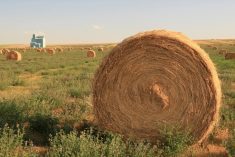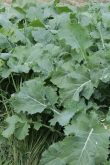Canadian exporters say they’re receiving more overseas inquiries for high-quality forage.
Last May, one inquiry led the Canadian Forage and Grassland Association (CFGA) to organize a trade mission that brought representatives from Al Dahra Holding LLC, an Abu Dhabi-based agribusiness that trades three million tonnes of forage annually, to tour Ontario, Saskatchewan and Alberta.
Siju Varghese, Al Dahra’s director of global sourcing, attended the mission. He explained that as part of the company’s expansion strategy, they came to Canada looking for suppliers who can provide a long-term uninterrupted supply of high-quality timothy, alfalfa and grasses.
Read Also

Canadian Beef Check-Off Agency reports on investments and activities
The check-off agency’s work behind the scenes is what ensures cattle check-off dollars are invested wisely, accounted for transparently and deliver measurable value back to producers and importers.
“As an exploration phase, the mission was good,” says Varghese. However, he says Canadian forage producers need education about the export market, and perhaps government intervention, to encourage them to explore it in more depth.
“Government, both provincial and national, should take some serious measures to encourage farmers and producers to go to international markets. Canada, in general, has an immense potential to grow in their international market. Due to the weather change all over the world, Canada can contribute much from the shortfall of Europe and USA as well.”
CFGA chair Chris Martin, an Ontario forage producer who exports through the Ontario Hay and Forage Co-operative, was part of the trade mission. He says it provided a good introduction to the volume and quantity Al Dahra is looking for, but the challenge for Ontario is supplying the consistent quality Al Dahra wants.
“The Canadian West has more acres so they have lots of hay that is all the same, where Ontario acres are smaller,” says Martin. “Having said that, transportation is an issue and I think we can compete from Ontario on that level with the outbound shipping that we have.”
Building relationships
Martin says there are challenges to exporting overseas and that it takes more time and effort to ship globally than to ship to the U.S. He stresses the importance of having the right people to take responsibility of the loads and who understand quality. “If you have too many middlemen, it doesn’t work, but you need the right connection to make it work as well.”
Other experts also recommend building relationships. Josh Callen, a market research analyst and owner of The Hoyt Report, says the most successful exporters are the ones who have teams dedicated to logistics and have good relationships with shippers.
“They seem to be the ones that have weathered the storm the best. So developing and leveraging those relationships with your shippers, I think, is the best way to handle that.”
Eric Boot, an Alberta forage producer who supplies his forages to an exporting partner, also encourages relationship building, especially for producers interested in getting involved in exporting forages. He says to start by finding a local plant that will take their product and also reaching out to local growers who are servicing the market to learn from them and see what the parameters are for the product.
“It’s always very important for export that products be great quality, not necessarily from a standpoint of rain — hay does get rained on; it can still make export — but the moisture percentage and such has to be right.”
Market trends
That said, current market conditions have buyers looking to make deals. Callen says high prices, especially in the U.S., as well as tight conditions in southern France, parts of Spain and Northern Italy, are driving that trend. “We’re seeing really strong demand from Japan and Korea for Canadian timothy.”
He says exports of Canadian timothy to those two countries were up 37 per cent the first six months of this year and 72 per cent jump over the same period in 2020. “What I think is driving that is they’re looking for deals and Canadian timothy is typically priced a little lower.”
Callen has noticed there’s also Asian demand for straw grown in Oregon and Washington, underscoring that they are willing to take something that is lower quality if the price is right.
“It’s just a fibre; there’s not much feed value to it because it has a straw, but the demand for that stuff has been through the roof and the prices on it have been really strong.” Callen believes there will also be more demand for the middle- to lower-grade hay.
Alex Christensen, president and CEO of Southeast Hay Distributors in Florida, says the new-crop pricing in North America is seeing an unprecedented increase for several different types of forage. As a result, buyers are looking for lower-cost options. Christensen says this is the case in the Caribbean as well because it’s a tough market to serve logistically.
“Cargo movement into the Caribbean has become a lot more expensive and there’s less service options so it’s really been more competitive than ever. The Caribbean markets have tightened up.”
In the Middle East, cost is the greatest challenge due to the increased freight rates and there are concerns that relationships in North America may become of less value simply because buyers will look for lower-cost alternative forages and even other feed ingredients.
“These are two different markets that I have experienced and I think both have different challenges to overcome, but overall I think consumers are going to survive this year,” says Christensen. “The consumer market adapts to rising costs and they find substitute products that meet their requirements so they can feed their animals.”
Equine opportunities
Christensen believes that while the equine market is smaller and not as attractive to some high-volume producers, the value of the product makes it worth considering.
“The equine market is always going to be strong,” he says. “I think Canadian producers can land product for cheaper. I think they can make these retail stores more competitive. And therein lies that opportunity.”
From a logistics standpoint, Christensen says there are strategic trade lanes between the U.S. and Canada that provide leverage to Canadian producers to increase their sales price if they’re handling the transportation costs, and still be competitive when they land their product into the market because they can benefit from lower-cost transportation rates into the U.S.
Tips for producers
Building relationships is just one piece of advice for producers interested in getting into the business of exporting forages. Here are some other tips:
- Play the currency game. Market research analyst Josh Callen says exports from Canada to the U.S. have slowed compared to last year when exports were high because of the drought in the northern states. Wetter seasons in Montana and the Dakotas means there has been less need to buy as much Canadian hay. However, with the dollar value being so high, Canadian exporters can play the currency game as it allows them to be more competitively priced.
“It’s been really hard for the Japanese customers, particularly because the year ended at a 20-year low to the dollar, so the Japanese yen doesn’t go near as far when they’re buying U.S. products,” says Callen, advising Canadian producers to use that to their advantage. - Be aware of U.S. prices. Distributor Alex Christensen recommends producers know what the pricing is in the U.S.
“The U.S. is the biggest exporter of forage products and with the way the pricing is that’s another thing to pay attention to because you can be more competitive if you know what’s going on down here pricing wise.” - Know your market. Christensen also says understanding the market before jumping in and transacting can save producers a lot of money upfront.
“Fact-finding missions are incredibly helpful,” he says. “Travel expenses are well worth it to come and look at what consumers are looking for.”
– This article was originally published as a Canadian Cattlemen supplement in the 2022 Forage & Grassland Guide.
















